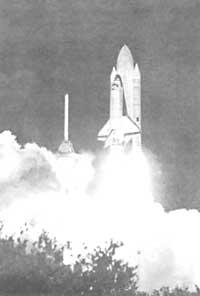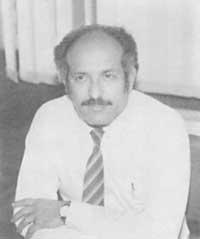M.S. El-Aasser with the teacher

Professor El-Aasser – I was born Egypton in 1942. I did my studies in Alexandria. Then I went to Mcgill University in Montreal, where I did my doctorate from 1966 to 1972. Then I went to Lehigh University of Pennsylvania with a scholarship. In 1974 I joined the Department of Chemical Engineering as an assistant professor. Three years later I was appointed associate professor and three years ago I became a full professor. At this time I am also director of the Lehigh Institute of Emulsion Polymers.
E. – What are your areas of research of interest?El-Aasser – In the broad field of Latex, my particular interest encompasses colloids, polymers and their chemical engineering aspects: I am interested in polymerization in its entirety, in kinetics, in characterization, in surface problems, in the problem of colloids and in some fields of application of these polymers, especially in the coating industry, and in the use of latex as a protein support in the biomedical field.
E.– At the morning conference he spoke about miniemulsions. What is the difference between miniemulsions and normal emulsions?El-Aasser – In miniemulsions we have drops or small particles, which means that this type of emulsions will have a natural stability. Macroemulsions have larger drops and when left in them the particles deposit or float depending on the density difference between them and the expelling medium. From this point of view, miniemulsions should provide a more stable system.
However, the importance of the process in which the miniemulsions are performed lies in their potential uses, some of which are already swimming and others not yet being new technology. The ability to achieve latex that cannot be obtained by this type of technology through conventional processes is also important. For example, if we want to use cellulosic polymers on a cover, you should dissolve the cellulosic material into an organic solvent, apply it later and let the solvent evaporate.
On the one hand, you are releasing an organic solvent, perhaps the carcinogen. On the other hand, the solvent has an economic cost, which is being spent. However, the miniemulsion does not pose problems of this type, but the polymer is dispersed in small drops or particles in an aqueous medium. The possibilities of this process have already been seen in different areas.
E.- Last year in a newspaper in San Sebastian, you were talked about in a news story titled "Microspheres to cure leukemia". What do you think?
El-Aasser – This is related to the work we have done on the NASA launcher. It was a matter of preparing polymer microspheres, of 5-100, in space, however, very monodisperse, which wanted particles of similar size. For this we have used the launcher.
The lack of gravity in the launcher allows us to maintain a more constant profile. Thus, when each particle grows from small to larger, it will have a similar environment. It should be noted that the system in which we are working has dimensions of 10 12 particles cms 3 and that if you want to achieve a narrow distribution of size, the particles must have the same temperature in the growth process.
If during polymerization some particles had more heat than others, that is, a higher temperature, the polymerization speed of the former would be greater than that of those with lower temperature. It is therefore essential that all particles have a similar environment. If this process is done on the ground, the particles tend to float or sediment depending on their density. This leads to the temperature inside the reactor not being uniform.
When the process is done in space, no agitation is required to keep the particles in suspension. This also allows us to grow the particles and avoid the coals, since the shear is very small. If we try to do this process in the soil, with particles of 10, for example, so that there is no sedimentation that requires a very strong agitation. This would lead us to have a large shear, the large shear would cause the particles to collide with each other violently and we get sea particles.
E. – How is the process in space?El-Aasser.– The largest seed particles we can obtain on Earth are deposited swollen with monomer or patches in the reactor. The reactor enters the projector and when it reaches space the astronaut turns on the heaters and polymerization begins. Now do not beat, the particles will remain in the seat and at all times. When polymers are brought to the ground they are very glazed.
Polystyrene at room temperature is like glass, particles are not marine sand like a pitcher full of water. In the next flight we use these particles as seeds. So far we have had five trips and in the last we have achieved particles of 32, in addition to a very narrow standard deviation of 1.5%.
E.– And about applications...El-Aasser.– On the use of particles, the first use is the calibration of the instruments. From this point of view, the National Bureau of Standards has accepted and certified as primary standard the particles of 10 that were obtained on a first flight. From June they will be released for instrument calibration.
This has been the first commercial product that has been achieved in space, which will be manufactured in space and sold on land. This is certainly the key to space marketing.
There are many other uses of these particles, due to their uniformity and size, coming to the field of Cancer research, especially in the treatment of leukemia, work has been done not with our particles, but with similar particles. Several particles were prepared with a magnet inside, 3. Specific functional groups were established on the surface of the particles. The particles were treated to retain an antigen to these functional groups.
These particles that contain adhesive proteins come into contact with the bone marrow of the leukemics, that is, it is passed through an exchange column that contains these particles. Once passed, the leukemia cells will join the specific protein. Distribution will be obtained. This experiment has been conducted in three or four hospitals worldwide. However, it is known that if an anticancer treatment is effective, wait a few times and see if the cancer is broken. We are in this case.
The key to this type of application is the manufacture of particles of different size with a great uniformity.

El-Aasser.– I think so. De factum NASA has taken many steps in this direction. It is currently being tested in the US for the creation of research teams. Its main objective will be that of processes that, due to lack of gravity in space, can be profitable. In addition, the space station for 1990-92 will be in orbit, the launcher will only be used as transport truck for people and material... And this is in five years!
The future does exist, there is great potential. However, we will have to wait a few years to see if the possibility becomes reality. I believe that in principle they will be products of great value and little volume: special metallic crystals, amalgams for semiconductors, latex...
E. – Thank you, professor.
Buletina
Bidali zure helbide elektronikoa eta jaso asteroko buletina zure sarrera-ontzian











